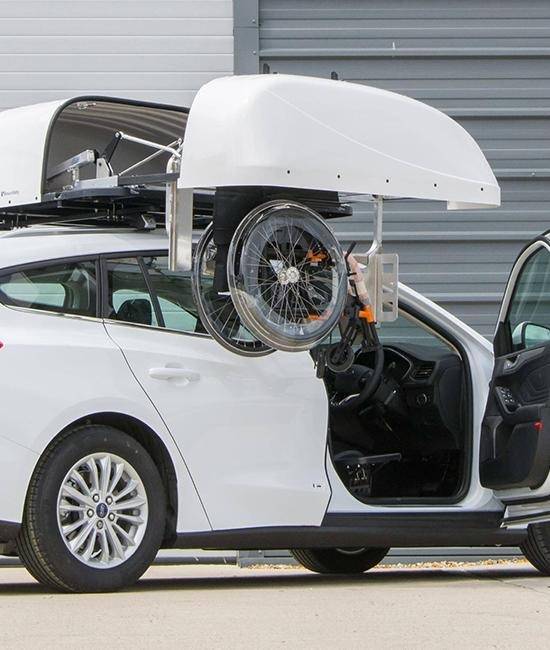Guide to buying a wheelchair accessible vehicle
Wheelchair Accessible Vehicles and adapted cars offer a life-changing solution for disabled passengers and drivers to access their own vehicle and enjoy the freedom of travelling across the country, or just up the road.
In our guide to buying a Wheelchair Accessible Vehicle we navigate through essential considerations so you can choose the right solution for your needs.
Understanding your needs
The first essential step before buying a Wheelchair Accessible Vehicle is understanding your specific situation and needs. Is this vehicle for you or for a spouse or child?
If it’s for yourself, have you had a disability driving assessment to help understand your driving capabilities and what car adaptations would best suit your needs?
As well as understanding your individual requirements, you should also consider your lifestyle. Where and when will you be using the vehicle? How often? Will you have regular passengers? Do you require space for shopping bags and luggage?
All of these factors will contribute to your decision of the needs and wants out of your vehicle.
Types of wheelchair accessible vehicles
Fortunately there are a number of accessible vehicle solutions to suit varying needs. It’s extremely important to explore all available options to ensure you select the right travel solutions for your specific needs and lifestyle.
Vehicle adaptations are by far the most popular solution as they can be fitted into hundreds of different makes and models, affording you a greater choice of cars to suit your preferences. This allows you to enjoy all the benefits and luxuries of standard cars, but making them accessible and driveable to your individual requirements.
An alternative option is a Wheelchair Accessible Vehicle which is a van derived vehicle that has been converted to enable a wheelchair user to travel within the vehicle whilst remaining seated in their wheelchair. Typically the floor is lowered with a fitted ramp so the wheelchair user can enter through the rear or side of the car. These are predominantly to accommodate passengers, however there are some Drive From Wheelchair Accessible Vehicles also available.
A Drive From Wheelchair Accessible Vehicle is much like a regular Wheelchair Accessible Vehicle in the sense that they are converted vans, but they also allow wheelchair users to travel and drive in the front driver’s position whilst in their wheelchair. Driving adaptations can also be fitted into these vehicles for those unable to operate the standard functions.
Entry and Exit considerations
As mentioned above, WAV’s typically offer rear or side entry via a fitted ramp, but which is right for you?
Side entry enables you to retain the vehicle’s boot space and provides access for street parking as well as disabled parking bays, but does require more manoeuvrability from the wheelchair user when getting positioned in the car.
Rear entry allows for more comfortable access by eliminating the need to manoeuvre angles to get positioned. It is also ideal for parking in regular car park spaces without the fear of getting blocked in.
For standard vehicles you can fit a range of vehicle access adaptations such as person hoists or swivel seats to allow you to get seated from a wheelchair into the car seat.
Interior space and seating configurations
As mentioned above, there are various types of WAV’s which offer different setting configurations. This enables you to prioritise your personal requirements and, ultimately, your comfort.
A Rear Passenger WAV allows the wheelchair user to travel in the back as a passenger whereas an Upfront Passenger WAV enables the wheelchair user to sit up front as a passenger.
Alternatively there is an Internal Transfer WAV which means the wheelchair user can internally transfer from their wheelchair into the driver’s seat or there is the option to choose a Drive From WAV which allows the wheelchair user to remain seated in their chair in the driver’s position.
Safety features
It’s imperative to check the safety mechanisms for the user inside the vehicle when WAV shopping to ensure the well-being of passengers in transit. The safety belts and restraints within the vehicle (otherwise known as Wheelchair Tie-Down & Occupant Restraint System) that keep the wheelchair user safe during an accident must be compliant with ISO 10542 in order to be road legal and require a minimum standard of performance during a crash. You can check/request this from the dealership or WAV convertor.
Budget considerations
Of course, budget is another key consideration when buying a Wheelchair Accessible Vehicle. There is a range of financial assistance available to help towards the cost of a WAV or a car and any adaptations.
The most notable being the Motability Scheme, a government-funded charity which allows you to exchange your qualifying mobility allowance for a new car and vehicle adaptations. Alternatively, if you are registered as disabled, you are eligible for VAT exemption when purchasing your new car. Many people then use the money saved to buy their car adaptations.
Or it may be that you require a finance or payment plan to spread the cost into monthly manageable instalments.
Exploring all your available options enables you to choose the most cost-effective and accessible solution for your needs.
Maintenance and servicing
Like with any vehicle, maintaining and servicing your adapted vehicle is crucial to ensure it remains in optimum condition and preventing unwanted breakdowns. Although not a legal requirement it is highly advised to take your car for a regular service and if you are leasing your car, it is often a contracted requirement anyway. If your car is leased through the Motability Scheme, the cost of your service is covered by Motability.
It’s important to choose a qualified mechanic to conduct your services as they will have access to the appropriate replacement parts and tools.
For regular day to day maintenance, many checks can be carried out by yourself. It is recommended to spend 5-10 minutes every few weeks to check your FORCES, which stands for Fuel, Oil, Tyres, Coolant, Electric and Screen wash.
With our adapted vehicle guide, buying a Wheelchair Accessible Vehicle is a simple process. Take your time and try as many options as you can; It won’t be long before you discover your perfect ride. Our team is available to advise on a wide range of vehicle adaptations, contact us to find out more.
We also have a blog covering alternatives to a wheelchair accessible vehicle to provide you with more options to meet your specific needs.
To help with your search for a wheelchair accessible vehicle, view our blog covering the best cars for disabled passenger access.

Driving with adaptations
Alternatives To a Wheelchair Accessible Vehicle
When requiring a vehicle to accommodate a wheelchair user, either as a passenger or driver, many people think that their only option is a Wheelchair Accessible…

Accessible travel
Finding The Best Car For Disabled Passenger Access
When it comes to finding the best car for disabled passenger access, there are several features and adaptations to consider to ensure a vehicle will meet…

Accessible travel
How To Apply For a Blue Badge For Disabled Parking
If you are disabled, have limited mobility or a health condition that affects your mobility, you can apply for a Blue Badge.